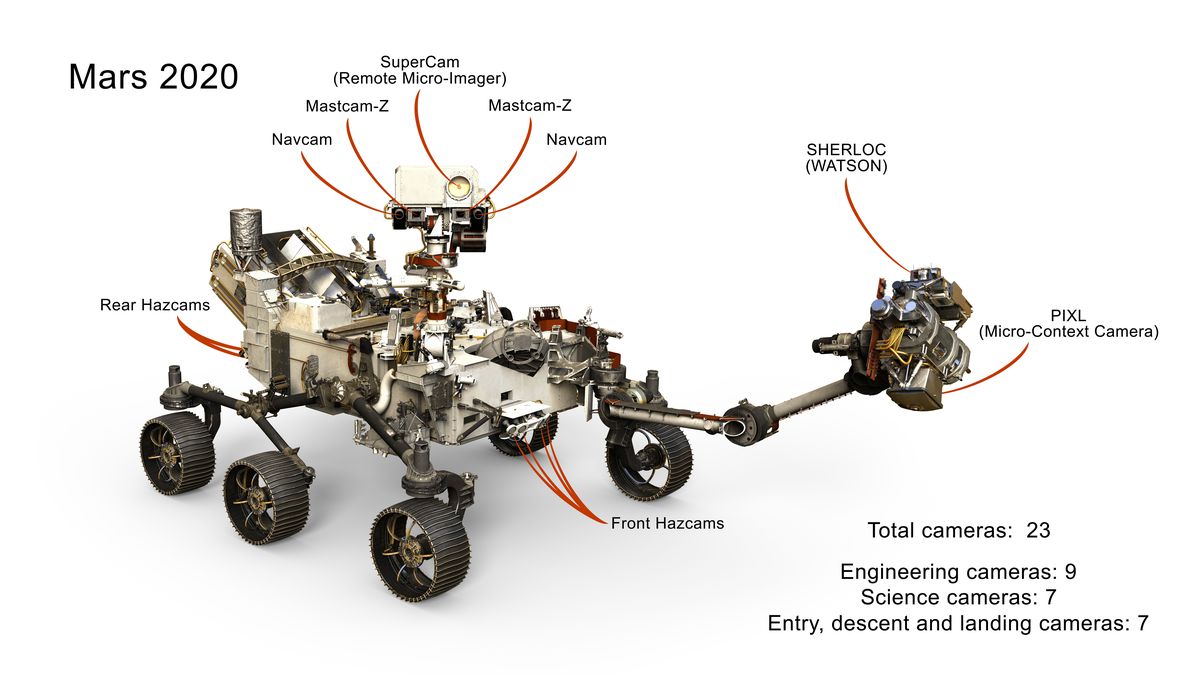
At 3:55 pm ET on February 18, NASA’s Perseverance rover finally landed on Mars, completing a journey through space that began last July. The fifth rover to land on the red planet, this boxy, car-sized vehicle with an extendable arm is now charged with looking for signs of ancient life and gathering data about Mars’s geology and climate. It will even lay the groundwork for eventual human exploration of the planet.
To make all that possible, the rover carries a stunning display of technology designed especially for Perseverance’s historic mission, from pieces of a new spacesuit to an autonomous helicopter, the first aircraft ever sent to another planet. Those tools will help the rover gather data about the planet’s atmosphere, which it can then send back to NASA. There’s also an excavation system that can collect high-quality samples of Martian soil to be stashed and later analyzed by a future mission to Mars.
In the years the new rover is expected to operate, these machines will battle challenges that terrestrial technology never has to deal with, including Mars’s super-thin atmosphere, limited resources, incredibly cold temperatures, and delayed communication with human overlords on Earth.
To give you an idea of how all this will happen, we’ve outlined some of the coolest features that will be on display now that Perseverance has finally arrived on Mars.
Perseverance is armed with advanced self-driving tech
Table of Contents
Key to its mission’s success is the ability for Perseverance to self-drive. The vehicle has a computer devoted to its autonomous capabilities, and as Wired explains, it was designed and built specifically for this mission. The autonomous driving feature is essential because Mars is simply too far away for humans to give the vehicle constant, real-time instructions. So the rover needs to fend for itself.
“One of the fundamental constraints of any kind of space exploration — whether you’re going to Mars or Europa or the moon — is that you have limited bandwidth, which means a limit on the amount of information you can send back and forth,” David Wettergreen, research professor at Carnegie Mellon’s Robotics Institute, told Recode. “During the periods of time when the robot can’t communicate, autonomy is important for it to enable it to keep doing tasks, to explore on its own, to make progress, rather than just sitting there waiting for the next time it hears from us.”
[embedded content]
But building an autonomous vehicle for Mars is not necessarily as easy as building a self-driving car here on Earth (and that’s not easy, either). For one thing, the vehicle needs to be primarily concerned with safety, not with speed or the comfort of its passengers. After receiving basic instructions from humans about where it needs to go, Perseverance has to figure out the least-dangerous route on its own. If it crashes, the rover might render itself useless.
“Mars is not a fixed, flat, nice, paved road. Mars is really challenging terrain. There is dirt, rocks, sand, slopes, cliffs — all these things that the rover is going to have to avoid,” explained Philip Twu, robotics system engineer at NASA. “In addition to cameras, the rover is also going to need computers, algorithms, and software to be able to process all that imagery data into essentially a 3D picture that it’s then going to go ahead and use to plan.”
Fortunately for Perseverance, Mars is not a place where a self-driving rover needs to worry about crashing into another car or hitting a pedestrian.
“On Mars, there’s nothing moving around,” said Wettergreen. “They’re moving slowly, so they can take the time to build a detailed model, do a lot of analysis on that model, and then decide what to do next.”
A robotic arm will take samples of Mars that will be studied back on Earth
The vehicle is also armed with a 7-foot-long arm equipped with a drill that’s designed to collect rock and soil samples from beneath Mars’s surface. Those samples will then be stored in as many as 43 containers that the rover carries around on the planet. Once those samples are collected, they’ll be left in tubes that will sit on Mars’s surface for a future mission to pick up.
The arm alone isn’t all that impressive as a piece of space technology. Instead, its virtue is all the stuff that it comes, well, armed with.
“It’s like a Swiss Army knife of scientific instruments,” said Wettergreen. “What’s so amazing about it is all of these different functionalities and capabilities that they’ve been able to pack into such a small package.”
For instance, on the arm is a robotic claw equipped with a laser and other tools, including a camera called Watson that NASA compares to “a geologist’s hand-lens, magnifying and recording textures of rock and soil targets,” which is part of a tool — fittingly named Sherloc — that comes with special spectrometers and a laser. There’s also a tool called PIXL that can analyze incredibly tiny chemical elements and, in NASA’s words, take “super close-up pictures of rock and soil textures” to help scientists figure out whether Mars could have been home to microbial life in the past.
High-tech cameras and microphones will give the rover “senses”
Integrated into the rover are a slew of extremely high-quality cameras — 23 in total — that will help the vehicle survey the planet. The cameras won’t just help Perseverance get around Mars, but they’ll also take images of samples collected on the planet and record the vehicle’s arrival on the surface in full color. Meanwhile, NASA says that so-called “engineering” cameras will take on tasks like helping the vehicle avoid potentially treacherous areas, like sand dunes and trenches, while others will help the system navigate without human intervention.

At the same time, the rover will pick up sound data through its two microphones. Those devices will listen to the rover as it arrives and travels on the planet. There’s a special microphone that works in conjunction with a laser to study the chemistry of the planet’s geology by zapping it and recording the sound of the zapping. As NASA explains, the microphone hears the intensity of the “pop” made by the laser turning the rock into plasma, which “reveals the relative hardness of the rocks, which can tell us more about their geological context.”
A self-driving helicopter will fly on another planet. That’s a first.
Also aboard the rover is Ingenuity, which will — if all goes as planned — be the first helicopter to fly on Mars as well as the “first aircraft to attempt controlled flight on another planet,” according to NASA. That makes Ingenuity an experiment on its own, one that has undergone extensive testing on Earth. Its mission is to demonstrate that flight on Mars, where it will conduct up to five test flights, is possible, and that flights can be conducted autonomously on the planet.
While the device is essentially a drone, it’s specially crafted for Mars, which has less gravity than Earth. This makes ascent easier, but due to the planet’s comparatively thin atmosphere, flight itself is more challenging. As The Verge reports, the blades of the helicopter can make more than 2,000 revolutions a minute, several times the speed of helicopter blades whipping around in Earth’s atmosphere. Ingenuity is incredibly light, weighing in at around 4 pounds.
[embedded content]
But the tiny vehicle’s autonomy is not just designed to help with navigation; it’s also built to keep Ingenuity alive.
“Mars is very, very cold. It gets to about negative 130 degrees Fahrenheit at night. That’s pretty cold,” explained Twu. “So the autonomy onboard the helicopter is also involved with finding a way to keep the helicopter warm enough to survive all the Martian nights.”
If the helicopter is ultimately successful, it will help NASA make decisions about where flight could lend assistance during future missions to the planet. Similar drones could serve as scouts that survey the terrain of Mars — especially places that rovers can’t easily get to — or, as NASA says, become “full standalone science craft carrying instrument payloads.”
Will we be seeing any of this tech on Earth one day? It’s hard to say right now, but Twu notes that NASA is famous for its spinoffs.
“Time and time again, we’ve seen that technology developed for NASA missions — a lot of them for space missions — end up having terrestrial applications here on Earth,” he said. “All technology development can cross-pollinate and advances in one area inevitably result in advances in other areas.”
Update, February 18, 2021, 3:58 pm ET: This piece was updated to include that Perseverance has now landed on Mars.
Open Sourced is made possible by Omidyar Network. All Open Sourced content is editorially independent and produced by our journalists.






